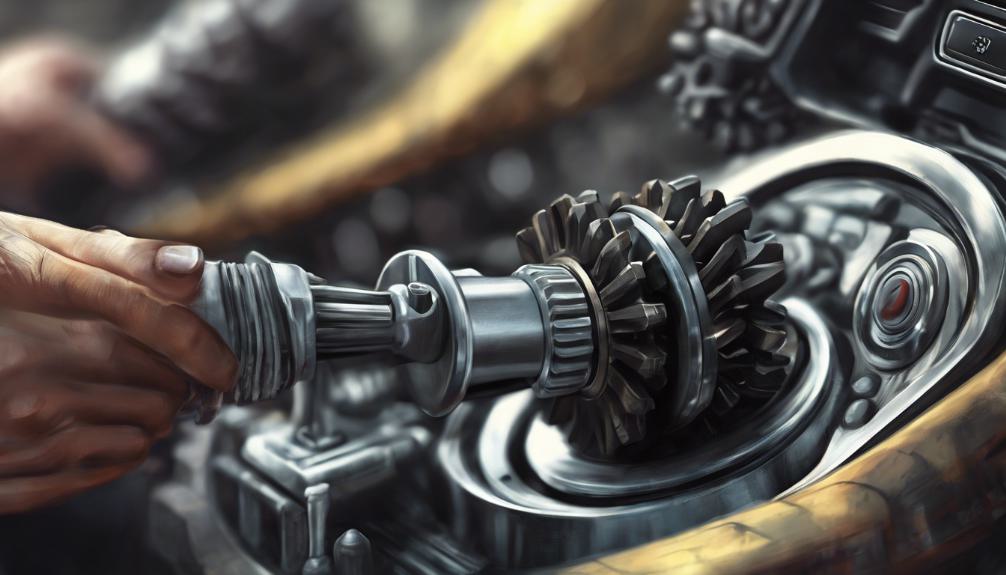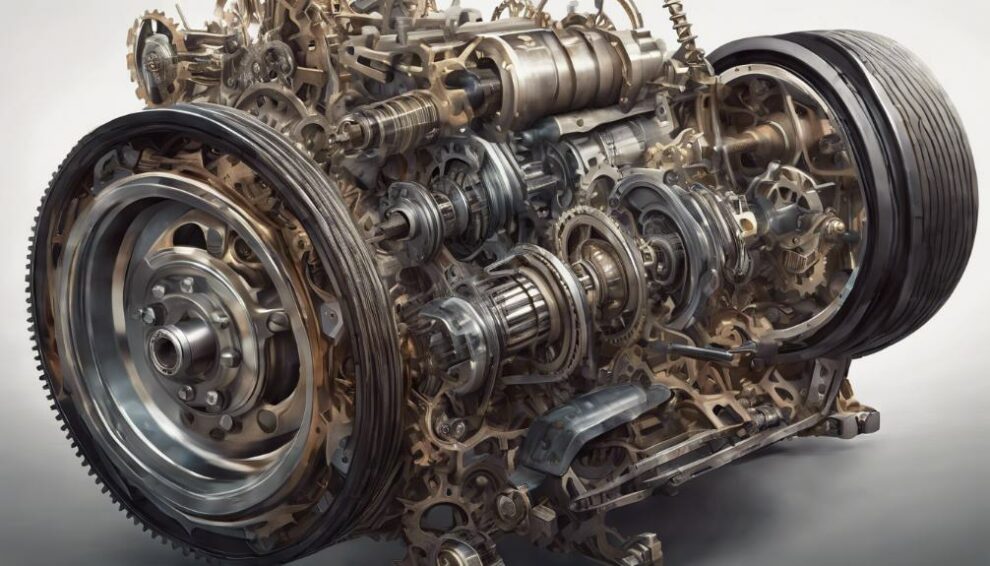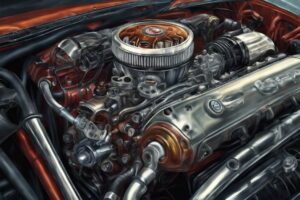When you shift gears in your car, the gear shifter mechanics play a crucial role in achieving a smooth transmission.
Components like the shift control ECU, shift cable, and park neutral switch collaborate for proper gear selection.
The shift lock mechanisms prevent accidental shifting by necessitating specific conditions like brake application. Inside the shift linkage, a lever and rod assist in achieving accurate gear shifts.
Understanding these mechanisms is essential for efficient driving. Exploring the inner workings of your car’s transmission components can help you better maintain and optimize your vehicle’s performance.
Key Points
- Gear shifter mechanics involve the shift control ECU coordinating gear shifts in automatic transmissions.
- Components like the shift lock mechanism and shift linkage ensure precise and safe gear selection.
- Understanding gear shifting techniques optimizes vehicle performance and transmission efficiency.
- Proper maintenance of the shift linkage is crucial for accurate gear shifting.
- Shift lock mechanisms prevent unintended shifter movements and ensure safe gear changes.
Importance of Gear Shifter Mechanics

Understanding gear shifter mechanics is essential for smooth driving and proper transmission function. When it comes to transmission efficiency, the way you handle the gear shifter plays a vital role.
By mastering shifting techniques, you can optimize your vehicle’s performance and fuel economy.
Efficient shifting guarantees that the engine operates in the most suitable gear for the driving conditions, promoting smoother acceleration and deceleration.
Proper gear shifting not only enhances transmission efficiency but also prolongs the lifespan of your vehicle’s components.
By selecting the right gear at the right time, you can prevent unnecessary wear and tear on the transmission system.
Learning to shift gears smoothly and at the appropriate RPM can greatly improve your driving experience while maintaining the health of your car’s transmission.
Mastering shifting techniques empowers you to take full control of your vehicle’s performance, ensuring that every gear change is executed with precision.
By understanding the importance of gear shifter mechanics, you can maximize the full potential of your car’s transmission system.
Components of Automatic Transmission Shifter
The automatic transmission shifter comprises various components that work together to facilitate smooth gear shifting and transmission control.
Some of the key components include the shift control ECU, wires connected to the brake light switch and key ignition switch, a cable for altering directions in the transmission, a park neutral switch on the transmission, and an electronic solenoid for releasing the shifter from the park position.
Disassembling the shifter involves tasks like disconnecting the shift cable, removing bolts to lift the shifter base, detaching the shift linkage consisting of lever pivots connected to a plate and rod, and removing the rod to detach the shifter assembly from the vehicle.
Shift lock mechanisms prevent shifter movement without the necessary brake, key, and lever conditions being met.
Inside the shift lock ECU, there’s a black tab that’s secured until the release button is pressed, a circuit board with a slider mechanism, a switch indicating lock, release, or shifted position, and a solenoid that controls shifter movement.
This complex system of components guarantees proper functioning of the automatic transmission shifter.
Inner Workings of Shift Linkage

Crafting a well-designed shift linkage enhances the precision and efficiency of your automatic transmission shifter‘s gear selection process.
The linkage design of an automatic transmission shifter includes a lever that pivots, connected to a plate and rod for accurate gear selection.
By disconnecting the rod from the shift linkage, the shifter assembly can be detached from the vehicle for maintenance or repair, allowing easy access to its components like the shift button, overdrive button, and position indicator housing for user interface and functionality.
The shift linkage plays an important role in translating the movement of the shift lever into the desired gear selection within the transmission.
Proper maintenance and adjustment of the shift linkage are essential to ensure smooth and accurate shifting of gears in the automatic transmission system, making it essential for the overall performance of your vehicle’s transmission.
Be sure to keep this component in good condition for an excellent driving experience.
Role of Shift Lock Mechanisms
To guarantee safe and controlled shifting of gears, shift lock mechanisms play a crucial role in preventing unintended movements of the shifter.
These safety features guarantee that specific conditions must be met before the shifter can be moved, such as applying the brake, having the key in the ignition, or meeting lever requirements.
The operating principles behind shift lock mechanisms involve two main mechanisms.
The first mechanism restricts shifter movement unless the necessary conditions are fulfilled, preventing accidental gear shifting without the shift lever being depressed.
The second mechanism requires pressing the shift button to shift into the park position, adding an extra layer of safety to the process.
A solenoid within the system controls the movement of the lock release tab in the shifter assembly, ensuring precise and secure gear changes.
In critical situations where immediate shifting is required, an emergency shift lock release button is available, highlighting the significance of these mechanisms in maintaining safe and controlled gear shifting.
What Are the Common Issues with Gear Shifters and How Do They Affect the Transmission of a Car?
When it comes to understanding service shifter alert, it’s important to be aware of common issues with gear shifters. Problems like worn-out bushings, low transmission fluid, or a faulty shift solenoid can cause issues with shifting gears. Failing to address these issues promptly can result in damage to the transmission of a car.
Functionality of Shift Control ECU

Shifting smoothly between gears in your car relies on the precise coordination of the Shift Control ECU, which orchestrates the automatic transmission system‘s functionality.
The ECU programming is vital as it directs the operation of the automatic transmission shifter based on input from various sensors and switches.
These sensors provide real-time data to the ECU, allowing it to determine the best timing and method for gear shifts, ensuring a seamless driving experience.
Then, the ECU integrates with the solenoid to facilitate the release of the shifter from the park position once specific conditions are met.
This seamless communication between the ECU and the transmission components is essential for efficient gear changes and overall vehicle performance.
The Shift Control ECU’s role in the automatic transmission system highlights its importance in maintaining the vehicle’s smooth operation and drivability.
Maintenance Tips for Gear Shifter
Regularly checking and adjusting the shift linkage guarantees smooth and accurate gear changes in your vehicle.
Shifter lubrication plays an important role in preventing sticking or binding of the shift assembly components. By keeping these parts clean and well-lubricated, you can avoid potential issues with shifting.
If you encounter problems with gear shifting, troubleshooting the shifter adjustment is key. Common issues such as difficulty getting into gear or the shifter feeling loose can often be resolved through proper adjustment.
Also, inspecting the park neutral switch for proper function is essential to prevent any starting issues.
Don’t forget to test the shift lock release button periodically to ensure it activates smoothly in case of emergencies.
Consult your vehicle’s manual for specific maintenance recommendations related to the gear shifter system, as different cars may have unique requirements for peak performance.
Stay proactive in maintaining your gear shifter to enjoy a trouble-free driving experience.
As an Amazon Associate we earn from qualifying purchases.










